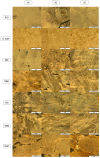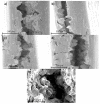Comparison of Different Additive Manufacturing Methods for 316L Stainless Steel
- PMID: 34772039
- PMCID: PMC8585356
- DOI: 10.3390/ma14216504
Comparison of Different Additive Manufacturing Methods for 316L Stainless Steel
Abstract
In additive manufacturing (AM), the technology and processing parameters are key elements that determine the characteristics of samples for a given material. To distinguish the effects of these variables, we used the same AISI 316L stainless steel powder with different AM techniques. The techniques used are the most relevant ones in the AM of metals, i.e., direct laser deposition (DLD) with a high-power diode laser and selective laser melting (SLM) using a fiber laser and a novel CO2 laser, a novel technique that has not yet been reported with this material. The microstructure of all samples showed austenitic and ferritic phases, which were coarser with the DLD technique than for the two SLM ones. The hardness of the fiber laser SLM samples was the greatest, but its bending strength was lower. In SLM with CO2 laser pieces, the porosity and lack of melting reduced the fracture strain, but the strength was greater than in the fiber laser SLM samples under certain build-up strategies. Specimens manufactured using DLD showed a higher fracture strain than the rest, while maintaining high strength values. In all the cases, crack surfaces were observed and the fracture mechanisms were determined. The processing conditions were compared using a normalized parameters methodology, which has also been used to explain the observed microstructures.
Keywords: 316L; additive manufacturing; direct laser deposition; mechanical properties; selective laser melting.
Conflict of interest statement
The authors declare no conflict of interest.
Figures















References
-
- Milewski J.O. Additive Manufacturing of Metals. Spinger; Basingstoke, UK: 2017.
-
- Yang L., Hsu K., Baughman B., Godfrey D., Medina F., Menon M., Wiener S. Additive Manufacturing of Metals: The Technology, Materials, Design and Production. Palgrave Macmillan; London, UK: 2017.
-
- DebRoy T., Wei H.L., Zuback J.S., Mukherjee T., Elmer J.W., Milewski J.O., Beese A.M., Wilson-Heid A., De A., Zhang W. Additive manufacturing of metallic components—Process, structure and properties. Prog. Mater. Sci. 2018;92:112–224. doi: 10.1016/j.pmatsci.2017.10.001. - DOI
-
- Malekipour E., El-Mounayri H. Common defects and contributing parameters in powder bed fusion AM process and their classification for online monitoring and control: A review. Int. J. Adv. Manuf. Technol. 2018;95:527–550. doi: 10.1007/s00170-017-1172-6. - DOI
-
- du Plessis A., Yadroitsava I., Yadroitsev I. Effects of defects on mechanical properties in metal additive manufacturing: A review focusing on X-ray tomography insights. Mater. Des. 2020;187:108385. doi: 10.1016/j.matdes.2019.108385. - DOI
Grants and funding
LinkOut - more resources
Full Text Sources
Miscellaneous

